
copyright 2007 by George Johnson
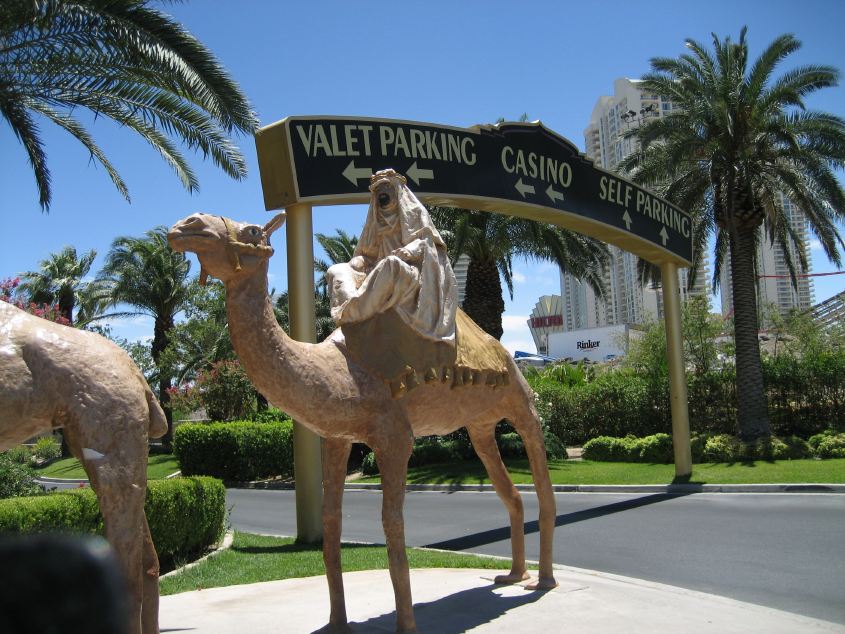
The Sahara, Las Vegas, photo by George Johnson, copyright 2007
1. Retrofit Arithmetic (and Rainbarrel Economics)
2. The San Juan-Chama Shell Game
3. The Case of the Disappearing Aquifer
4. The Creative Hydrology of Suerte del Sur
5. The City, the County, and a Water Tax Revolt
6. Water Numerology at City Hall
(Our story thus far)
7. The Woman at Otowi Gauge
8. "Forget it, Jake. It's Chinatown."
9. The Las Campanas Connection
(Our story continues)
10. The Engineering Solution
July 14, 2007
43. The State of the City
Searching back through the archives of the daily New Mexican, one finds that Santa Fe's first "state of the city" address was delivered in the spring of 1996 by Mayor Debbie Jaramillo. "I know there are people in the community who believe that I've spent the last couple of years parking illegally, hiring everyone in my family, fighting in the streets and arguing with my colleagues," her honor complained, then went on to describe what else she had done. Printed at a cost of more than $5,000 and illustrated with photographs of Ms. Jaramillo, the speech was in retrospect the first salvo in her unsuccessful bid for reelection.
As best I can tell, the next such address came three years later from her successor, Larry Delgado. He pointed to cleaner parks, fewer potholes, a stronger police force, a streamlined planning division, and a more responsive City Hall -- even a fine new civic facility on the south side of town. Then it was the Genoveva Chavez center, now it is the Southside library. Rereading the story from August 1, 1999, calls forth a heavy sense of deja-vu. We learn that morale among city employees was, as usual, lower than ever, that born-and-bred Santa Feans couldn't afford to buy houses. Eight years later how very little has changed.
Or so it seemed until the first really good state of the city address delivered on Thursday by Mayor David Coss. Finally after all these years we are hearing specifics: extending the minimum wage -- the highest in the country -- to even the smallest businesses, doubling the recruitment budget for the police, and most significant of all, allocating 1,000 acre-feet from the city's annual water budget back to the river.
Unless sabotaged by the developers, the difference this would make is huge. In his last state of the city address Mr. Coss vaguely hoped for a day "when children don't ask where the Santa Fe River is." Now he is offering a way to make that really happen.
Before the city pulled the plug last month, 10 acre-feet a day was flowing out of the dams and all the way to Agua Fria. A thousand acre-feet earmarked for the river and not for more houses would mean a hundred more days of summer flow. The destruction of the bosque would be reversed. The over-pumped aquifer would begin to recharge. The Santa Fe River would live again.
Mayor Jaramillo had good ideas but not the political skill to execute them. Mr. Delgado, the perfect mayor for the 1950s, just wanted to cut ribbons and visit Sister Cities. Having spent a year learning on the job, Mr. Coss now seems ready for action. And he may just have the politesse to forge the compromises that will make his ideas real. Whatever one thinks of the tradeoff on the minimum wage -- more about that later -- it is no small accomplishment to get a free market zealot like Al Lucero (owner of Maria's New Mexican Kitchen) shaking hands with social justice activists like Carol Oppenheimer. If Mr. Coss can forge the same kind of alliances among the eight headstrong members of City Council then maybe Santa Fe after a decade of stagnation can begin to move ahead.

July 15, 2007
Postscript
A message this morning from Marilyn Bane, who ran unsuccessfully last year against Rebecca Wurzburger for the District 2 council seat, reminded me of something Councilor Chavez had mentioned during our recent encounter on Atalaya Trail. The $250,000 donation to the Southside Library from Dr. William Herrera was not the pure act of eleemosynary kindness that I implied in my dispatch of June 17. Dr. Herrera, of course, was the owner of the land for the new Super Wal-Mart. He and the company agreed in negotiations with Mr. Chavez to make the donation in return for the Council's approval -- this was two years ago -- of the building plans. It is unclear why the money was given in the dentist's name rather than Wal-Mart's. Perhaps the corporation can now be persuaded to kick in another $750,000 for what would be christened the Wal-Mart Southside Library. That would be just a fraction of the money the company saves from a tax loophole that State Representative Peter Wirth tried to close during the recent legislative session.

King of the Hill
You might think it would be uncomfortable living so exposed on a hillside like this one on the northeast horizon.
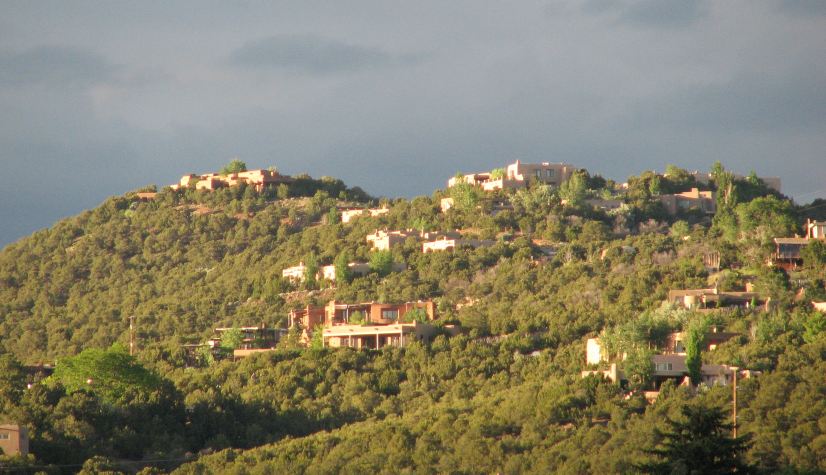
It could be worse. Two of the requests, both on the Northside, involve rebuilding demolished houses, and Mr. Sommer assures us that only part of the new Cañada Ancha building will encroach on the ridge top. None of these projects, Mr. Sharpe reports, would even require variances had it not been for an amendment last year by Councilor Heldmeyer that closed the loophole Andrew Davis snuck through.
It used to be that the most sought-after property was in the bottom lands, down by the water and the rich alluvial soil, where it is flat, easy to build, and protected from the winds. Land like that on which Tom Ford is building was junk real estate. The finest homes in Santa Fe, on upper Canyon Road and in Tesuque, don't have much of a view.
Our land use laws didn't envision a day when so many individuals would be as wealthy as corporations, requiring headquarters instead of houses, engineered and lawyered, built to the incalcuable detriment of everyone below.
July 17, 2007
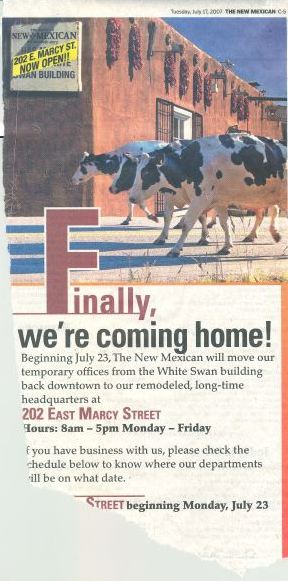
Posted without comment.

July 19, 2007
When you see a huckster standing on the corner of Cerrillos and Zafarano waving a giant arrow beckoning motorists to the new Centex subdivision, you know that the local housing market is in a slump. For confirmation just look at the anemic real estate section in Sunday's New Mexican. At the height of the season there are only 10 pages with one plugged full of fillers ("Pets of the Week," "Trash to Treasures"). Another carries the jumps from real estate cover stories, which in better times were relegated to the classifieds section. This cutback in advertising amounts to thousands of dollars a week in lost income for the paper. But fear not. Santa Fe's ever effervescent realtors say that despite a 26 percent drop in sales, the market remains healthy. What would constitute an unhealthy market is left to the imagination.
Meanwhile there appears to be no die off in the ranks of speculators pushing for lot splits. Eight such cases are on the agenda for the Planning Commission's Summary Committee, which meets on August 2.
If (more like when) all these are approved, the result will be more traffic, more noise, more water and sewer hookups -- a lowering by another notch of the quality of life for everyone around.
July 20, 2007
Stranger Than Fiction
In Junkyard Dreams, a new novel by Jeanette Boyer, a character named Rita Vargas presides over an automotive graveyard in south Santa Fe as it is steadily being overtaken by suburban sprawl. Hard pressed for money to pay doctor's bills, she reluctantly agrees to sell a steep hill on the edge of her land to a realtor named Leroy Sena. The site is all but unbuildable, he tells her, so she needn't worry about intrusive new neighbors. He is doing her a favor by taking it off her hands.
The realtor turns around and sells the ridge to Joe Oakes, assuring him that he can build not only one house but four. He'll just have to bend the rules a little. The slope is too precipitous to accommodate the 24-foot-wide access road required for a small subdivision. But there is room, just barely, for a narrow driveway.
Leroy's brother, Gilbert, who happens to work for the city planning department, explains to Joe how these things are done:
You apply for a building permit for that site, say nothing about any other houses, and put in your driveway. Afterward, you apply for a permit to subdivide the lot and put in three more houses. The road is already in place; nobody stops to question its width.
"Trust me," Gilbert says. "It's a common device for getting a subdivision approved on a hilltop."
It's an engrossing story and one that rings true. Real estate manipulations may be a bit more subtle these days. If Ms. Boyer is looking to write a sequel she might consider the story of Jim Kirkpatrick.
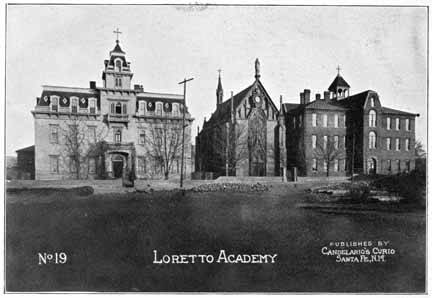
Mr. Kirkpatrick is a well-known local developer. In 1971 he bought the Loretto Academy downtown from the Sisters of Loretto, then tore down most of the historic buildings to construct a hotel -- a kind of parody of Taos Pueblo now operating under different ownership as Loretto Inn and Spa. Mr. Kirkpatrick still runs the old Loretto Chapel, dwarfed and engulfed by the hotel, where for a price you can have "your very own unforgettable Santa Fe wedding." For the last 13 years he has been trying to get a permit to erect a multistory office and condominium complex on the now vacant part of the property bordering Water Street (where the building with the mansard roof, at the lefthand side of the photograph, once stood).
In yesterday's New Mexican, Phaedra Haywood describes Mr. Kirkpatrick's latest venture, with his brother Charles. Together, we learn, they own an 80-acre parcel southeast of town, which has been divided into four 20-acre tracts -- separately deeded to each man and his wife. Wishing to create still more lots without having to abide by county subdivision rules, the Kirkpatricks came up with a plan that would make Leroy Sena smile: All four spouses would split their lots in half. Then invoking a loophole allowing for "family transfers," they would generously give each other 10 acres. In the end they would have created what amounts to an unregulated subdivision. "Estate planning," Jim Kirkpatrick calls it.
The family transfer provision was put into the land use code in deference to the long-standing norteño tradition of handing down ever smaller pieces of the old family ranch to new generations of heirs. (What happens when the parcels become the size of coffee tables has yet to be addressed.) The law of course cannot discriminate according to ethnicity. It was for other reasons that the County Commission upheld an appeal by neighbors who argued that the rules were being abused. As their lawyer, Jim Alley, put it:
When you shuffle lots back and forth between people who already own the land, there is no real transfer of property. If you let this go through, you'll have a line of landowners coming in here playing a game of shuffle with their spouses.
That, it appears, is now set to happen. With Karl Sommer as their attorney, the Kirkpatricks have succeeded in getting a District Court judge to overturn the county's denial.
Ms. Boyer's novel has a mostly happy ending. Joe Oakes gets his comeuppance and Rita Vargas gets just one house staring down at her from the hill. The final chapter of the Kirkpatrick saga is less certain, awaiting a decision from the county commission on whether to appeal.
July 25, 2007
Fire and Rain
The day before Thursday's deluge, my rain barrels were down to the dregs. After so promising a beginning, this summer's monsoon season was beginning to look like a bust. Far from it. From that single cloudburst I measured an inch and a half in a pan accidentally left outside. Two inches or more were reported farther up Santa Fe Canyon, flooding some houses on Cerro Gordo Road along with the Upaya Zen Center. My neighbors up there seem to have been impressed by the quick, professional response of the Fire Department. I didn't even know you could call the Fire Department about floods.
The road crews were also right on the case. Saturday morning, as I drove up Cerro Gordo to the trailhead by the hairpin turn, there was little sign of the washout. In one section sandbags had been stacked along the street -- like something you would see in Pasadena.
I parked and walked up an arroyo that just days before had been a river. The rusting chassis of an old car, abandoned decades ago and full of sand and bullet holes, was still there, its steering wheel tangled in brush from the torrent.
Half a mile north I turned onto the side spur that passes through the Cerros Colorados ghost town, intersecting with the trail that runs from Hyde Park Road back down to Cerro Gordo. That part of the walk is not so nice anymore, with the new mansions looming overhead. I hurried beneath them making my way to Fred Klein Blvd. -- an abandoned public utility road that a local developer tried to claim a few years ago as his personal driveway. But that's another story.
As I walked back to my car, I passed by some of the houses that had been flooded. They're in a precarious situation, perched on a steep incline between the road and the river. Above them, on the other side of Cerro Gordo Road, newer houses -- whole subdivisions of them -- are stacked up the hillside. The hard, overgrazed soil probably wouldn't have absorbed much water anyway, but it can't help having all that concrete and asphalt up there.
In Junkyard Dreams, Joe Oakes was required to construct settling ponds to mitigate runoff. On Cerro Gordo the settling ponds are apparently other people's backyards.
July 28, 2007
Night Crawlers
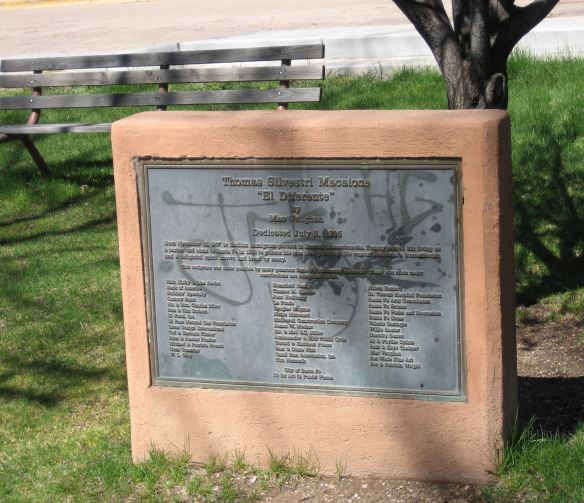
My idea of a fun Saturday morning is to load my Jeep with accumulated recycling or yard clippings and head for the transfer station out on Paseo de La Vista. As I drive I flip the radio back and forth between KUNM's "Folk Roots" and whatever is on KBAC, "Radio Free Santa Fe" -- which is what I was doing a few hours ago when I heard the voice of Julia Goldberg, the editor of the Reporter. She was leading a discussion with some people in the local music scene about an issue that doesn't much concern me in my middle age -- Santa Fe's lack of a night life.
I've heard the complaints ever since I arrived here 15 years ago: There is a dearth of bars playing live music, and the ones that try -- Chez What, the Paramount -- inevitably go out of business for lack of a clientele. What that says to me is that there is not much of a demand, but the people on Julia's show seemed to concur that one of the biggest problems is an "Orwellian" -- someone actually used that word -- crackdown on drunken driving, with officers waiting outside bars to pounce on unsuspecting customers and employees.
To illustrate the point the owner of a club told the poignant tale of a bartender who, after finishing his shift, had two drinks before driving home. He was arrested for DWI. Of course if he really had only two drinks he wouldn't have failed a breathalyzer test, but it was an illuminating story. At a time when other Santa Feans are worrying about an understaffed police force, a recent series of rapes, gang shootings in public parks, purse snatchings in broad daylight on St. Michael's Drive, and a soaring number of burglaries, some people actually believe they are living in an iron-fisted police state.
I don't think they need to worry. It's been almost a year now since the Council passed a $1.5 million property tax -- half of what the mayor asked -- to strengthen the police and fire departments. While the firefighters seem to have rebounded, there has been no real progress on the police staffing situation. For every officer hired another takes early retirement.
In the face of all this, a modest request from Chief Johnson for authority to close city parks half an hour after sunset (right now that would be about 8:40 p.m.) is hysterically depicted by the New Mexican as a crushing assault on human rights. The parks are already closed by law at 10 p.m., and no one is ever rousted out for sitting quietly looking at the moon. Why not demand that the Genoveva Chavez Center or the Marty Sanchez Links be kept open 24 hours a day?
A more sensible objection to the earlier curfew is that it probably wouldn't work. In a city where seeing an officer on the street is like spotting a rare owl, neither late-night loiterers not drunken club hoppers probably have much to worry about.
July 31, 2007
Her Town
For many years Marilyn Proctor, formerly of The Management Group and now with Kokopelli Property Management, has made a living by representing home owners who have surreptitiously turned their houses into high-class motels.
"Imagine telling your friends that 'Melanie Griffith, Meg Ryan or Billy Bob Thornton slept in my bed,'" she said in an article, Buying Vacation Rentals in Southwest Hotspots, which appeared in a Wall Street Journal real estate supplement. According to the report, which didn't mention that short-term rentals are illegal, each of Ms. Proctor's clients stands to make $20,000 to $80,000 a year, of which she and her company get 25 percent.
No wonder she was livid last year when the city finally began facing up to the degrading effects these zoning violations are having on Santa Fe's neighborhoods. "Why is the city targeting us?" she demanded at a hearing. "Why is the city taking our lives to task? I am offended that we're constantly being called illegal."
It was a revealing statement about human nature. Get away with breaking the law long enough and you feel not only lucky but entitled.
With another hearing on the issue scheduled for Thursday before the Planning Commission, this sense of righteousness seems only to have intensified. In this morning's Journal, Ms. Proctor blames attempts to rein-in short-term rentals on "relative newcomers [who] want to come in and tell us how to run our town."
Ms. Proctor was born in New York, according to a profile on her former employer's website, and came to Santa Fe 30 years ago -- long enough to feel, like Debbie Jaramillo, that anyone who crosses her just got off the bus.
August 5, 2007
I didn't vote for Karen Heldmeyer in 2000 when she ran against one-term incumbent Molly Whitted. Though I often felt at odds with Ms. Whitted's conservative politics, I'd worked with her as a board member of Santa Fe Beautiful, waging an uphill (nearly vertical) battle against litter and graffiti. In the darkness of the voting booth, a sense of loyalty or a muscular twitch caused me to pull the lever by Molly's name. I was glad that it was Karen who won.
She had come from the Neighborhood Network, a coalition of citizens' groups that once showed promise of becoming a force against the development and real estate interests. That didn't happen, but it was encouraging when two years after the election Karen joined with Councilors Miguel Chavez, David Coss, and Patti Bushee to fight (unsuccessfully in the end) for a genuine water budget, one that would have reined-in the construction frenzy that is close to ruining Santa Fe. When in retaliation she and two of the others were targeted in the 2004 campaign by the Santa Fe Grassroots thugs, I quickly lined up to support her.
It wasn't only Karen's politics that got my attention but her doggedness in prodding a sluggish city bureaucracy to respond to constituents' complaints. (Those in government who would rather be left alone call this "micro-managing.") Several years ago, when the public works department made a unilateral decision to turn a peaceful woods across from Cristo Rey Catholic Church into a heavy equipment yard, it was Councilor Heldmeyer who came out at 6 a.m. to witness the annoyance of being awakened every morning by a dozen backhoes firing up and then roaring their way to work. With her help and that of a good lawyer, neighbors persuaded the city manager to move the operation to an area zoned for industrial use. (Now the Canyon Association hopes to turn the site into a public park for the quiet enjoyment of nature.)
With an increasing crush of money riding on real estate speculation, the coming campaign promises to be just as brutal as the one in 2004 (which is chronicled in the archives of The Santa Fe Review). As she announced on Friday, Karen Heldmeyer won't be running. An editorial in the New Mexican eloquently describes the loss. The one consolation is that she plans to keep working behind the scenes, with the hope of accomplishing more on her own than she could as a councilor.
It is probably the right decision. As hard as Karen works, her bluntness has sometimes gotten in her way. She can be quick to take offense and reluctant to let go of a grudge. The one bond she has formed on the Council, with Miguel Chavez, hasn't been enough to tip the scales against the steady commercialization of every facet of Santa Fe life.
It's not just Karen. One of the great disappointments over the last year has been watching such natural allies as Councilors Bushee, Heldmeyer, Chavez, and Chris Calvert, along with Mayor Coss himself, eyeing each other with suspicion, working at cross purposes when together they could change this town.
August 14, 2007
Last night the Finance Commitee approved Councilor Wurzburger's bill to legalize, with only minimal restrictions, vacation rentals in residential neighborhoods. Only Councilor Calvert voted no. The sole surprise at the meeting, as reported in the Journal, was Ms. Wurzburger's assertion that Mayor Coss has agreed to support her bill. If so, he is reneging on his campaign promise "to ensure that the law currently on the books is not weakened and that it is vigorously enforced." (Please see my posting for July 3.)
I've written so much about this issue that I will restrict myself to quoting from an op-ed piece in Sunday's New Mexican by John Pen La Farge, the son of Oliver La Farge, the American writer and anthropologist who is remembered for his advocacy of historical preservation.
"Rental agencies have exploited Santa Fe for years," John La Farge writes.
These "citizens" have broken the law, and they have done so in full knowledge of what they were doing. Realtors have, also, sold houses by encouraging buyers to pay off their mortgages by means of short-term rentals. They've sold property by suborning others into illegality, although they do not explain this to the buyers. . . Bad citizenship is bad citizenship, whether or not the city enforces its own laws.
The result, he notes, is the disintegration of neighborhoods into commercial zones and, off season, ghost towns of vacant rentals owned by absentee investors. "One cannot have a 'neighborhood watch' with no neighbors," he writes. "The less stable the neighborhood, the greater the rate of crime."

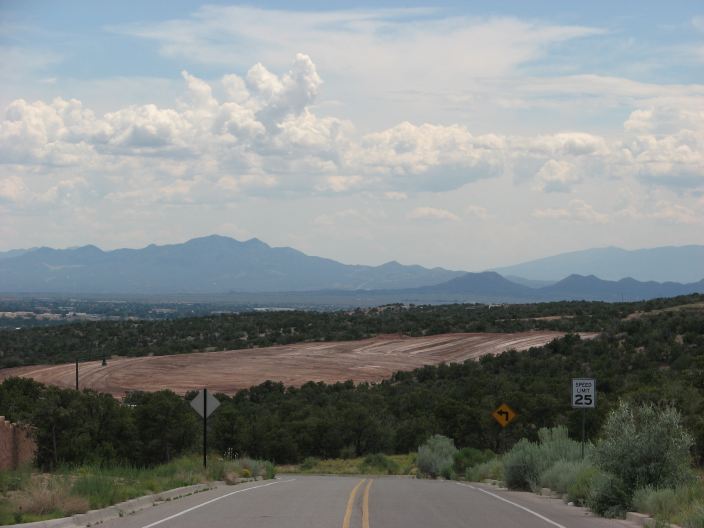
In other news, the Journal reported that shares of Thornburg stock fell by 21 percent yesterday after Standard & Poor downgraded its credit rating. Today it dropped by another 47 percent to $7.61 a share -- making it worth less than a third of what it has traded for within the last year. Though the company shuns subprime mortgages in favor of home loans for the wealthy, it is apparently caught in the same credit squeeze as other practitioners of creative financing.
Meanwhile, as the company scrapes bare the seven-acre site for its new headquarters, a quote in the New Mexican from Concerned Residents of Santa Fe North indicates that the group has not given up its fight: "The fact that bulldozers are moving dirt does not mean that the building can be built without further challenge."
If Thornburg's financial prospects don't improve, maybe the city, which now owns the land, can use it for afforable housing or an ATV park.
August 23, 2007
Pulling a Pfeffer
There were plenty of tea leaves to read at last night's Public Works Committee hearing on Rebecca Wurzburger's attempt to legalize vacation rentals. Chairwoman Patti Bushee finally tipped her hand when she criticized the proposal as a political solution to a zoning problem -- the encroachment of commercial activity into residential neighborhoods. If Ms. Bushee sticks to her guns she might be counted on to join Karen Heldmeyer, Miguel Chavez, and maybe Ron Trujillo (who cast a no vote at the meeting) when the issue comes before the full Council.
Carmichael Dominguez, to no one's surprise, voted for the Wurzburger bill, but so did Chris Calvert -- reversing his earlier position and leaving some of his supporters wondering if he is "pulling a Pfeffer." (David Pfeffer, readers will recall, campaigned as a neighborhood activist and then performed an about-face, supporting the developers at every opportunity.) If Matthew Ortiz backs Councilor Wurzburger, as he tends to do, the vote might be 4-4 with Mayor Coss breaking the tie.
As noted here earlier, Ms. Wurzburger dropped a bombshell at a recent Finance Committee meeting when she said Mr. Coss was supporting her ordinance. Not so, the mayor said last night, hinting that he would try to broker a compromise.
One possibility would be to "grandfather-in" some of the illegal businesses -- but only if the owner lived on site and neighbors didn't object. No new operations would be allowed and the "nonconforming uses" would expire when the property changed hands.
Or the Council could simply direct the city to enforce the existing law in the same way it does litter and weed ordinances -- on a complaint by complaint basis. Well behaved operations would continue to fly beneath the radar while the abusers would be shut down.
August 24, 2007
Postscript
Several readers who attended the Public Works Committee meeting have written to emphasize a point that didn't appear in either the New Mexican or the Journal. Councilor Calvert, after offering some rather weak amendments (that much was reported), first moved to forward the Wurzburger proposal with no recommendation. When he didn't receive a second, he caved and went along with Councilor Dominguez in endorsing the bill. That leaves open the possibility that Mr. Calvert simply wanted to avoid further delays and in the final council vote will make good on his campaign promise to oppose commercializing residential neighborhoods.
The question is how best to do that. Also on the table (and unreported in the local press) are proposals to legalize short-term rentals only in certain downtown areas, like lower Canyon Road and its side streets, which are zoned Residential Arts and Crafts. RAC zoning, which was intended to allow artists to live and work at home, has been abused for years, the argument goes, so we might as well do the lawbreakers a favor and acknowledge the status quo. If that view prevails then why stop there? Maybe we can look forward to a Holiday Inn Express tucked away on Camino Escondido along with office buildings (we already have Karen Walker Realty on Delgado Street) and an Allsups convenience store.
The reason Councilor Wurzburger opened this Pandora's box was at the behest of the Rousselots (owners of The Management Group) and her other friends in the real estate industry. Maybe, on second thought, the fairest thing to do would be to slam closed the lid and start prosecuting people who put personal profit above the erosion of everything that has been special about this town.
Background reading on the short-term rental mess:
Two Quiet Victories and Promises, Promises
Coming forthwith:
The Battle for Talaya Hill
The Andrew and Sydney Davis Webcam
Santa Fe Review Detours of the Wild West
The Santa Fe Review
More links:
See the current flow of the Santa Fe River above McClure Reservoir
with
the USGS automated gauge.
The Otowi
gauge shows the flow of the Rio Grande north of Santa Fe.
Santa Fe water information, a collection of documents and links

 on to Part 44, Before the Fall. . .
on to Part 44, Before the Fall. . .
